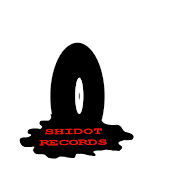
The USSRPM Workshp, a rare photo found in a Vladivostok warehouse archive in 2001
Crouching figure is assumed to be Ivan Egorov .
SECRET MUSICAL WORKSHOPS IN SOVIET RUSSIA, NOT FOR MILITARY USE BUT FOR THE LISTENING PLEASURE OF THE KREMLIN HEADS AND CHIEFS.

The USSRPM head quarters logo which sparked intial interst.
WHO AND HOW?
After being called to investigate a fire in an abandoned warehouse, forensic investigator stumbled upon some damaged boxes in the basement that were so water damaged that only several tapes, photographs and documents were recognizable
One key piece, a sign bearing a logo, which was identified from Government records as the United Soviet Socialist Revolutions Per Minute.
The Investigator Vladimer Stokov choosing to ignore official guidelines and discard the items as pre Glasnost rubbish gave them to his younger brother music journalist Edward, who worked within the growing music popular music scene and its associated press in Moscow.
Edward Stokov instantly recognized the logo as the legendary but clandestine government operation the USSRPM, an experimental musical workshop that managed to avoid all types of interference and was the Mecca for Russian bohemians , artistic outcasts and musical savants.
Stokov went on a seven-year investigative journey and will publish his amazing story.
“We could’ve been bigger than the Beatles” in 2011.
Extracts taken from leaked portions and printed on Winklepedia.
The United Soviet Socialist Revolutions Per Minute (U.S.S.R.P.M) were established in the mid 1950s [1] after the death of Josef Stalin.
It was established as a direct competitor to the BBC Sound Workshop. It was first thought the USSRPM was set up for military purposes to discover ways to apply sound waves as weapons but this was discredited as US propaganda to hide the fact Americans were well advanced in this research themselves.[2] Another popular theory is that Nikita Khrushchev gave the go ahead to form an advanced sound academy because he hated the music Stalin had made everyone listen to in his youth and he also had a secret crush on Elvis Presley.[3]
Another hint towards the validity of this theory is the positioning of the USSRPM head office and studios. Vladivostok.
Though an important Military position, it was far enough away from the prying eyes of Moscow and spot inspection by the Politburo and was generally left in peace to do its research.[4]
The USSRPM was different in so many ways compared to 1950s Russia conditions and personal were quite liberal by the standards of the time and the workshop itself was not just populated with musicians but with technicians who specialised in electronic circuitry. The original purpose of the workshop was to create new music for a new world, though in later years they made a substantial income supply recorded soundtracks to European and American horror movies under a shelf company based in Canada.[5]
 One of the three known surviving photographs that sparked interest in what was the USSRPM.
One of the three known surviving photographs that sparked interest in what was the USSRPM.The man using the machine is believed to be Ivan Egorov, distinguishable yu his outrageous bouffant hairstyle for the times.
A true visionary that the world is only just discovering how much of an impact he has had on modern music.
Initially music that was produced by the workshop failed to stray too far from traditional paths, this reluctance was probably due to fear of persecution from upper authorities for being radical but it was Khrushchev who put an end to their worries when it was reported that he sent a communiqué stating “If I wanted to listen to this dirge I’d dig up Stalin’s record collection and play it without a needle”[6]
These earlier works were basically recordings of traditional Russian choirs with science fiction type sound effects dubbed over them.
There has only been one recording found from this era and this decription is quite apt.
This new found freedom and the release of the Dr Who theme track sent the USSRPM collective off into another sphere altogether.[7]
Early members of the workshop such as electronic genius Karl Alexandrov went onto develop laser beams that were useless for military use but when he defected became the light engineer for the Electric Light Orchestra.[8]

Ivan Egorov, with who is believed to be composer "Flatulence"
who modelled himself on Phil Spector in style and looks.
He claims to have invented the
"Wall of Static"
Musical whiz kid Ivan Egorov was almost a true pop star in his own right. Working behind the scenes he influenced people such as Robert Moog and has been heavily rumoured to be the genius behind the 1970s hit POPCORN.[9]
Many other scores and pop hits have been accredited to the USSRPM but evidence is lacking. In actual fact little remains of any proof that the workshop existed at all except some random photographs, letterheads and soundbytes found in old archives. Without these the whole history of the USSR would have disappeared into legend.
The workshop itself was disbanded during Glasnost and the entire studio staff defected to nearby South Korea and Japan to work in the then infant but growing Video Game Industry.[10]Sources
1. The Vladivostok Archive doc.124
2. U.S Congress Report #1247 1974
3. Citation need – in doubt
4. Heresay and general rumour
5. CNS doc#124m25-4
6. May not have happened but sounds good
7. 1963 Ron Grainer (Aussie Genius)
8. I did drugs with ELO – K Alexandrov Boston Press2000
9. Just a rumour
10. Nintendo

